I was in New York Thanksgiving week to give my 12-year-old son his first bite of the Big Apple. In two-and-a-half days we did as much as was humanly possible, everything from Broadway to the High Line, and a very famous skyscraper in between. Since he's a budding student governor, I decided to take Luco to international territory, where we visited the Design with the Other 90%: Cities exhibit at the U.N.
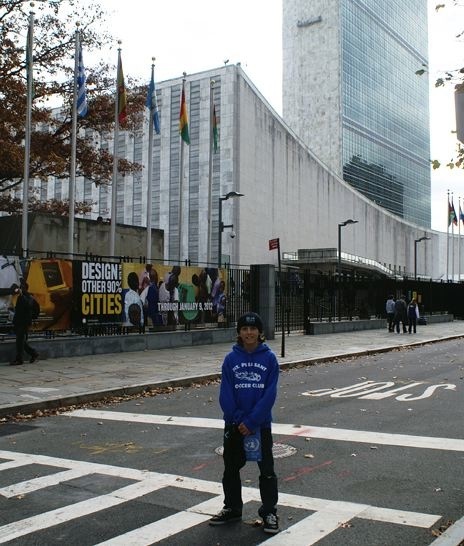
A 7th-grader in New York. Photo: David Stairs
I'd done a certain amount of background reading in preparation for this activity. Michael Kimmelman's October 21 architecture column for The New York Times, entitled "Rescued by Design," was the fluffy sort of design reportage I've come to expect from the mainstream press, long on goggle-eyed praise of the obvious, short on solid criticism. Mark Lamster's "Majority Report" review at Change Observer a few days later seemed more focused on the installation quality, and whether or not the show had been scooped by MoMA's "Small Scale, Big Change" exhibit than with analyzing the current exhibit's assumptions. I turned to the adaptation of the curator's catalog essay, posted at Places October 17.
Cynthia Smith, the Cooper-Hewitt's Curator of Socially Responsible Design, spent part of 2010 traveling to a number of the projects she selected for the exhibition. As such, she joined filmmaker Gary Hustwit and a recent exodus of Euro-American designers flocking to destinations in what Smith casually refers to as the "Global South." These pilgrimages, similar to the ones 19th-century Americans made to Paris when it was world art center, practice a form of design voyeurism, either looking for lives to enhance or researching instances of how western-style design might rescue the less fortunate from their birth fate. Rarely do the travelers discuss their experiences in even semi-permanent terms— they can't because they don't ever go to stay. As with Ivan Illich's infamous visitors from MIT, they arrive seeking grist for the interventionist's mill.
This is the second of Smith's 90% undertakings. In 2007, when the Cooper-Hewitt must have decided it was missing a leadership opportunity, she mounted Design for the Other 90% which, according to Smith, "...helped spark an international dialogue about how design could improve the lives of poor and marginalized communities around the world." With the hubris of all institutionally credentialed people everywhere and in all eras, she conveniently glosses the criticisms that forced her to change her language from designing for to designing with. A third candidate, one that puts in an occasional appearance in the show, is the always welcome designing by.
A Slum Is a Slum (Is a Neighborhood)
Smith's essay, densely foot-noted and painstakingly researched, deserves to be seriously analyzed and critiqued. She leans heavily on "expert" sources and regurgitates familiar stats about migration, urbanization and overpopulation that are meant to stun by their sheer outrageousness, but unfortunately, produce a yawn because of their frequent reiteration. MDG's and Agenda 21 facts are overused these days. Friends of mine who used to employ such statistics in their lectures have lately decided that these numbers have lost their impact, the "incredulity meme" grown as resistant as bacteria to penicillin.
The show itself isn't bad as such things go, and better attended than Mark Lamster suggested. It's a compilation, and suffers the decontextualized slings and arrows of such an approach.The favored projects in the show, like the Guangzhou Bus Rapid Transit System, or the Medellin Metrocable failed to impress me. Rapid transit corridors have been around for decades and can't really pass for innovations. Installing a cable car system to connect favelas to a city center is more original, but still feels less like design innovation for the poor than practical urban planning for a city's future.
Some exhibits, like the Community Cooker in Nairobi's Kibera neighborhood, which purportedly burns garbage to bake bread and cook other foods for local residents and is supposedly "...hot enough to burn plastic...without toxic fumes," are just too crazy for words. It's a given that garbage incineration is not only more expensive than landfill, but also creates trace amounts of dioxin, heavy metals, and fly ash that all have to be disposed. No self-respecting neighborhood in America would allow an incinerator to be sited in its backyard, let alone used to prepare food! Your neighborhood or my neighborhood are one thing, but because we're talking here about Kibera, the largest "slum" in East Africa, why be picky? Any intervention will be an improvement, right?
Smith's catalog essay often squeamishly refers to "stepping over open sewage" in the places she visits, as though humans haven't been doing this for ten thousand years. And they still do it in favelas, gececondus, barrios, and townships, with all the famous ones, like Kibera, Diadema, Khayelitsha, and Dharavi cited in her essay. We may think of these places as unfit for human habitation, but to their occupants these are neighborhoods, and all the disparaging language of hegemonic culture can't erase or prettify the fact that the people who live in these neighborhoods have been coping with their limitations and attempting to improve things for centuries. Institutions, like states and municipalities and yes, even museums, have not had to worry about this, have not, in fact, until relatively recently even noticed.
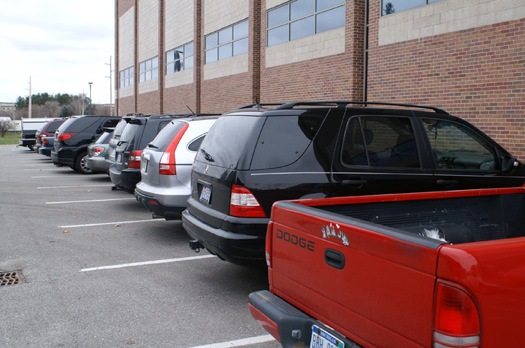
Behind my workplace, where 13 of 17 vehicles are either SUVs or trucks
Another telling reference in the catalog essay is to "...reducing carbon output in the urban areas of the Global South." This would be a great idea if there were a realistic way to do it. Cities of the South I've visited have nearly as many people on bikes as in cars. This doesn't ease pollution though, because climate variation acting on deteriorated infrastructure causes clouds of dust that mix with diesel exhaust, a real curse for the asthmatic. It isn't a matter so much of poverty as of population density. For example, New York's traffic volume hurts my lungs every time I visit. Then again, building floating community barges in Bangladesh to help river dwellers fight rising tides can't work if Americans continue their wasteful habits. In the parking lot behind my office most of the vehicles are SUVs and pick-ups with nary a hybrid in sight. So the idea that people of the developing world should give up similar vehicular comfort and convenience, things we've enjoyed since 1911, for an abstraction like a reduced carbon footprint, reflects one-sided wishful thinking, one of the biggest roadblocks to international climate change treaties.
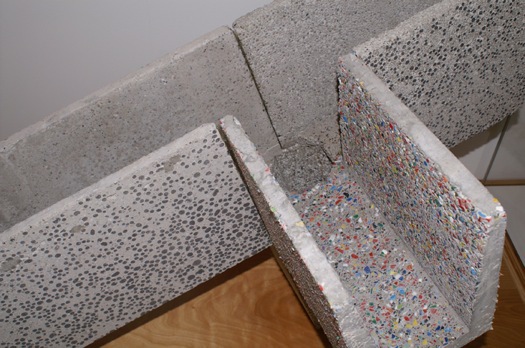 Formed concrete lightened with recycled plastic
Formed concrete lightened with recycled plastic The exhibition does have its good moments, the designing by parts. Once one gets away from the big splashy projects there are some charming small scale ideas like Prasetiya Mulya's Business School's cow dung and earth bricks that are cheap and durable, or MAS Zurich's formed concrete that is light-weighted by adding broken bits of ground up plastic. A couple of projects were designed by student groups, including Designmatters' Safe Agua System, implemented in Santiago Chile, and ...XYZ's erector set style bicycle. Development of this bike began at an ICSID Interdesign I participated in in Rustenberg in 2005, where I met the project's lead, South African industrial designer Roelf Mulder.
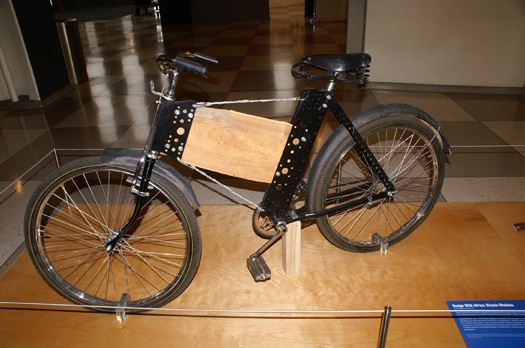
Design with Africa bike
A couple projects from Uganda, with which I'm intimately acquainted, seemed more dubious. Bas Hoefman and Hajo van Beijima's Text to Change project, which uses Airtel Uganda's wireless network to text information about AIDS to subscribers would be more impressive if I didn't know that Airtel is one of Uganda's smaller carriers. Khalid Arbab's Digital Drum Internet Access, which places internet terminals made from recycled 30 gallon drums in public places, would be convincing in an arid climate, but not, as exhibited, out of doors in Kampala, which is subject to torrential downpours that wash away streets. And Norsk Forms' bePRO Motor Taxi Helmet, which claims that 75% of hospital-reported injuries come from boda boda moped accidents, overlooks the fact that a majority of accidents in Uganda aren't reported at all. As with the earlier 90% exhibition, what you don't know can mislead you. So where does this leave us, other than cursing and fuming?
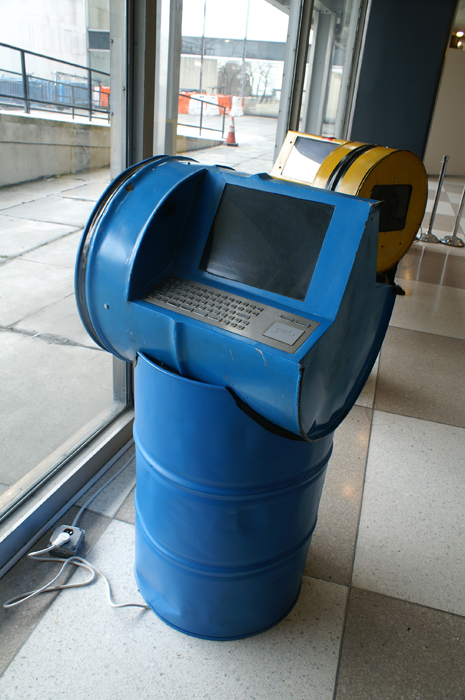
Internet barrel
Addressing Causes, Not Effects
In 2009 National Geographic Magazine published a reconstruction of Manhattan as it probably looked the day Henry Hudson sailed into a pristine island harbor on the mid-Atlantic coast of North America, thus beginning a 400 year process of urbanization which resulted in the transformation of a sylvan paradise into a hyper-developed nightmare. We tend to talk incessantly about "globalization" as if it were a recent development, but as Charles Mann outlines in 1493, the Spanish established the first global trading network with China nearly 500 years ago. First observation: 20-20 hindsight can help improve foresight.
Since Le Corbusier we've argued that high-density urban settings are the most efficient form of protecting the environment, but apart from humanity's built-in need to overproduce, the problem with cities seems to center on our social natures and the economic systems we've devised to serve them. Instead of building to interface with nature, we design to overcome it. Rather than thinking about collective good, we obsess over personal freedom. We can talk about poverty alleviation and "leapfrogging into the 21st century" 'til we turn blue in the face, but it won't make a damn bit of difference unless we control population. I know; easier said than done but, given the Chinese example, possible. Observation two: planning to alter human nature is much harder than planning to alter nature itself.
Into this mix we step with design "interventions." The problem is, when we plan big we often don't plan well. Think here of Brasilia, or the Interstate Highway System which cut a swath straight through the heart of many American cities in the ’60's. We have a disastrous record of designing for the poor, too, at least in America. Here I think of the failed housing projects of the ’50's, like Pruitt-Igoe in St. Louis: 2870 apartments in 33 eleven-story buildings that proved uninhabitable crime-generators and were finally imploded in the ’70's. Typical of our navel-gazing, in design circles the destruction of Pruitt-Igoe has been characterized as "the death of Modern architecture," rather than a failure of planning foresight.
All of these examples are top-down projects, precisely what Design with the Other 90% claims to eschew. But examples from the show, like the Indian Institute for Human Settlements, which worked "...in consultation with MIT, Stanford and Harvard, and with firms Arup and IDEO...creating a new profession [of] urban practitioners" leave me unconvinced if only because they include so many of the familiar and suspect opportunists seeking to benefit. And there's another consideration. A good percentage of the so-called "Other 90%" live right here in America. In places like Camden, New Jersey, or East St. Louis, Missouri, or Flint, Michigan, which has just been assigned an emergency manager by the Governor of Michigan. These unexotic former manufacturing cities of the Global North, what Olon Dotson calls the "Fourth World," need just as much help as their crowded sisters of the equatorial regions. Final observation: the 90% you need to save may be your own.
Demythologizing Design
Illich used to talk about the need to demythologize science. I'd like to extend the metaphor to design as a finishing point. When I heard Geetha Narayanan, the founder of the Srishti School in Bengaluru, speak in Turin at Changing the Change she told a story of how small holders banded together in a cooperative to form what became India's largest dairy products firm, AMUL. No designers. No interventionists. Just average people working together to improve their lot. Where the Cooper-Hewitt show shines is through the examples of similar individuals, percolating up from the BOP, coming from a variety of backgrounds, even the "peasantry." Examples of cooperative developments, like Buenos Aires MTL housing coop, or some of the work carried out by Shack/Slum Dwellers International are very hopeful. In many so-called developing societies cooperation is a necessary way of life.
Design with the Other 90%: Cities succeeds where it references interconnectedness. Smith's essay ends with a list of "must haves" including land reform, responsible environmental policies, inclusive design practices, transparency, and equity. It fails where it falls back upon tried and immodest truisms, like "scaling up for wider implementation." If we accept that "Understanding and using local knowledge are critical for successful design," then we must also accept that local ideas probably work best locally, and often can't be scaled, exported, or universally marketed.
Our relevance as western designers and design critics will ultimately be determined by the kind of prepositions we choose to employ as the world's economic system restructures: forget about "for"; "with" is a good one; "by" even better. Adhering to belief systems and economic philosophies that prioritize personal and professional advancement over collective survival is anachronistic. As a people and as a profession designers need to get past the past. We can't continue to practice the unsupportable, then design quick clever fixes to relieve the unthinkable. If we hope to veer from the cliff humanity is speeding toward, we need to make the momentous decision to address causes instead of effects. Designers need to be way more than clever, they need to be wise. It's the only "best practice" that makes any sense.
How to demythologize a profession striving mightily to establish its own myths? How about all the gobbledygook about Apple you've been ingesting since October? Stop paying attention to propaganda about the greatness of design. Remember that museums and professional organizations are really businesses that act in their own vested interest. Design is only a behavior pattern leading to an activity, not the master metaphor of existence. Make sure you are armed with a full complement of other valuable tools, including literacy, conviviality, 20/20 hindsight, and acute self-awareness before you try to terraform the earth. Otherwise, the world of the future will look as wrong in 400 years as the New York of today looks compared to Hudson's time. And that, in any sane definition of the word, will not be good.


Comments [5]
12.20.11
04:15
12.22.11
05:25
12.22.11
07:41
12.29.11
12:51
12.21.12
02:53